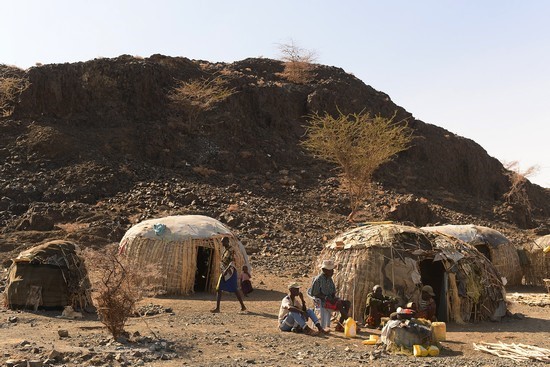EL MOLO BAY, Kenya — At first light,
children from one of
Kenya’s smallest and most isolated tribes put on life
jackets and board a fishing boat for the journey across the lake to school.
اضافة اعلان
Until recently, they could walk the distance. A road
connected the El Molo with the world beyond their tiny village, a lifeline for
a secluded community of fishers and craftspeople subsisting on the shores of
Lake Turkana.
But three years ago the lake started rising
dramatically, lapping at the El Molo’s domeshaped huts draped in dry fish,
then pushing inland, forcing villagers to higher ground.
As the tide reached levels not seen in living
memory, the El Molo watched their only freshwater pipeline slip beneath the
surface, as well as the burial mounds of their ancestors.
Eventually, the road to the mainland disappeared
completely, marooning the El Molo on an island in a lake so large and imposing
it is sometimes called the “Jade Sea”.
“There never used to be water here,” said El Molo
fisherman Julius Akolong as he crossed the wide channel that today separates
his community from the rest of far northern Kenya.
“You could drive a jeep across.”
Turkana, already the world’s largest desert lake,
stretching 250km tip to tip, grew 10 percent in the decade to 2020, according
to a government study published last year.
That expansion submerged nearly 800 additional
square kilometers of land including around El Molo Bay, where the tribespeople
live on Turkana’s eastern shores.
Extreme rainfall over catchment areas — a climatic
event linked to global warming — greater soil runoff from deforestation and
farming, and tectonic activity were all cited as contributing causes.
Blessings and curses
The phenomenon has profoundly impacted the El Molo, whose distinct
Cushitic culture was already under serious threat.
Barely numbering
1,100 in the last census, the El Molo are dwarfed by Kenya’s larger and more
prosperous ethnic groups that dominate a country of around 50 million people.
Known as “the
people who eat fish” by the livestock rearing tribes of northern Kenya, the El
Molo are believed to have migrated from
Ethiopia to Turkana around 1,000 BC.
But few today
speak a word of their mother tongue, and ancient customs have evolved or
vanished entirely through generations of intermarriage with neighboring ethnic
groups.
The lake’s
unexpected rise fragmented the remaining El Molo still following the old ways
of life.
Some displaced in
the disaster made the wrenching decision to relocate to the mainland, erecting
a squatter camp on the opposite shore.
The cluster of
shanties on a barren and windswept clearing is nearer to the school and other
facilities, but a world away from their tightknit community and its
traditions.
“It was very
difficult. ... We had to go and discuss this with the elders so they could
permit or bless us to go with no curses,” said Akolong, a 39-year-old father of
two.
For those who
stayed, life on the island has become a struggle.
The El Molo are
skilled fishers, but as Turkana rose higher their people went hungry.
The fishing nets
and baskets used for millennia, handwoven with reeds and doum palm fiber,
proved less effective in the deeper water, reducing catch.
 A family of the El Molo community sit outside their new make-shift house after being forced to relocate following the rising waters from Lake Turkana, near Loiyangalani, northern Kenya on July 13, 2022.
A family of the El Molo community sit outside their new make-shift house after being forced to relocate following the rising waters from Lake Turkana, near Loiyangalani, northern Kenya on July 13, 2022.
No longer able to
access freshwater, the El Molo were forced to drink from Turkana, the most
saline lake in Africa.
Children in the
village suffer chalky teeth and bleached hair, a side effect of the lake’s
high fluoride content.
“We often get
diarrhea. ... We have no other clean water. This is all we have. It is salty,
and corrodes our teeth and hair,” said Anjela Lenapir, a 31-year-old mother of
three who decided to stay.
Disappearing culture
School attendance has fallen sharply because parents cannot afford the
boat fare, said David Lesas, deputy head teacher at El Molo Bay Primary
School.
“Most of them
remain at home,” he lamented.
The local
government and World Vision, an aid group, are assisting but resources are
scarce and needs many in the region, which is experiencing a
once in a generation drought.
The school has
suffered too: the perimeter fence and toilet block are underwater, and
crocodiles have taken over part of the playground.
But the real
damage to the El Molo is indelible.
Separated from his
people, Akolong has missed initiation rites, naming ceremonies, and funerals —
rituals that strengthen tribal identity and community.
“We are now
divided,” he said bitterly.
Stone cairns
marking the resting place of El Molo’s dead have been swept away, erasing
memories of the past, while the lake threatens venerated shrines to tribal
deities.
“It is a place
that is deeply respected in our culture. With the water rising, we will lose
that tradition too,” said Lenapir.
Read more Lifestyle
Jordan News




